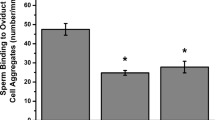Abstract
SPERM capacitation is the acquisition in the female genital tract of the ability to penetrate the zona pellucida1,2. In the rabbit the process is said to require a minimum of 6 h in the uterus2 and in the oviduct as well3. In experimental studies on capacitation, capacitated sperm can be obtained by two different methods: either spermatozoa from the ejaculate or from the epididymis are deposited surgically in the female tract (uterus or oviduct), or sperm are deposited in the vagina by normal mating or artificial insemination. Capacitated sperm can be recovered from the uterus 6 h or more later. When capacitation is evaluated in terms of yield of fertilized ova from suitable recipient does, it appears that surgical deposition results in lower efficiency of capacitation than does deposition by normal mating. Adams and Chang4,5 compared the two methods of preparing capacitated sperm and found that the yield of fertilized ova was 16 per cent with surgical deposition but 60 per cent with normal mating. Similar results were found in our laboratory9 and, although a different experimental procedure was used, average yields of 15.4 per cent and 69.3 per cent fertilized ova were observed, respectively, for the two types of capacitation methods9. The obvious difference between the two methods is the presence of coital stimulus in one and its absence in the other. Coital stimulus in the rabbit causes the release of pituitary LH (luteinizing hormone) which in turn induces ovulation. Experimentally, ovulation is induced by intravenous injection of LH4 (30 I.U.) or of HCG (human chorionic gonadotrophin) (25 I.U.), but the amount of LH actually released following normal mating is not at present known. We therefore investigated the effectiveness of capacitation after surgical deposition of sperm in the uterus of oestrous does.
Similar content being viewed by others
References
Austin, C. R., Austral. J. Sci. Res., B., 4, 581 (1951).
Chang, M. C., Nature, 168, 697 (1951).
Chang, M. C., Nature, 175, 1036 (1955).
Adams, C. E., and Chang, M. C., J. Exp. Zool., 151, 155 (1962).
Adams, C. E., and Chang, M. C., J. Exp. Zool., 151, 159 (1962).
Soupart, P., and Orgebin-Crist, M.-C., J. Exp. Zool. (in the press).
Hilliard, J., Hayward, J. N., and Sawyer, C. H., Anat. Rec., 148, 291 (1964).
Chang, M. C., Endocrinology, 63, 619 (1958).
Gemzell, C. A., Control of Ovulation, 192 (Pergamon Press, Oxford, London, New York and Paris, 1961).
Author information
Authors and Affiliations
Rights and permissions
About this article
Cite this article
SOUPART, P. Effects of Human Chorionic Gonadotrophin on Capacitation of Rabbit Spermatozoa. Nature 212, 408–410 (1966). https://doi.org/10.1038/212408b0
Issue Date:
DOI: https://doi.org/10.1038/212408b0
- Springer Nature Limited





